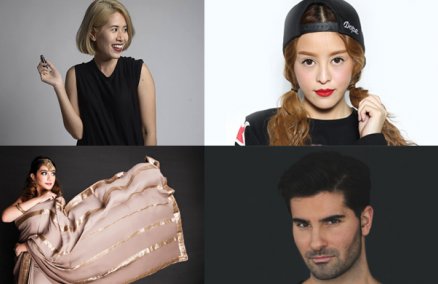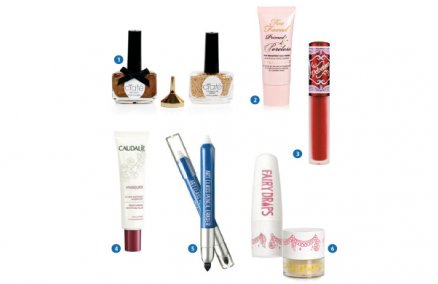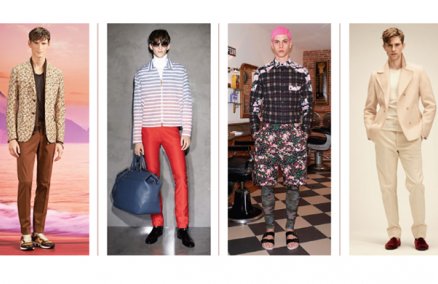In sidewalks, in shopping malls, in secret back rooms, in offices, in drug stores, in restaurants, in homes…perhaps even in your home (no!), we’re awash in counterfeit and pirated goods. And we’ve grown up with fake stuff—lightweight “Rolexes,” Grand Theft Auto installed from a blank CD, crap Chloe bags, “Abibas” shirts—so we can tell the difference, right?
Maybe not. Modern counterfeiters are making replicas so sophisticated, they can fool some experts. It’s not only backpackers from Europe who are buying fake jeans to sell on eBay to fund their extended holidays. More and more people who can afford the real thing are sporting fake watches and bags—you’d be surprised just how much is out there. No wonder Bangkok has been dubbed the “piracy capital of the world” by international news agencies.
Even some people who work for luxury goods manufacturers look at the issue philosophically: Imitation is flattery. “In the case of every brand that has become famous, counterfeit products have become unavoidable,” said Jirapat Nilwong, senior brand manager of luxury watches such as Panerai at watch purveyor Pendulum. “In a way, it shows the brand is becoming well-accepted in the market.”
Should we care that the guy next to us has a fake Gucci wallet? How would you feel if you unknowingly bought a fake Gucci wallet? What if the pirated software you bought that isn’t covered by a warranty failed and caused you to lose a month of work? Or what if the medicine that was supposed to cure you made you even more sick?
Keeping it real
While some items like handbags and shoes are knowingly purchased as cheaper versions of the real thing, other people can get duped by fakes passing themselves off as the real McCoy—a major issue in brand-conscious Asia. “You know if you go to Khao San Road, you’re getting a fake, but a mix-up between the counterfeit product and the real thing at the same price is a real problem,” says Suebsiri Taweepon, lawyer for international law firm Tilleke & Gibbins.
Some steps to make sure what you are getting is for real:
1. Go to the source. People are sure to have bought the real thing if they avoid buying from walkways, flea markets or the nice lady next door who got some presents from her stewardess friend. “The best way to avoid this problem is to buy these items from a reliable source,” says Suebsiri. For example, luxury handbag retailer Louis Vuitton has only three branches in Bangkok, so shoppers should be wary of LV-branded goods anywhere else.
Drug companies say the items most likely to be counterfeited are the expensive drugs, like anti-cancer medications, or those in high demand, like anti-virals. They recommend consumers purchase their drugs from legitimate sources such as hospitals or a reliable drug store instead of the Internet, and to check out special features on the packaging such as holograms.
2. Buy at a store with a good reputation. It’s no guarantee, but you can get your money back if you find out you’ve been duped.
3. Pay full price. Although not always a surefire indicator of whether the item is real or not, shoppers can be reasonably certain that a “branded” pack of cigarettes or polo shirt at a third of the price of those at the branch store is probably trying to pass itself off as the real deal.
4. Change your attitude. Counterfeit goods reward people who are stealing ideas from someone else and making money off of them without giving due credit. So if you don’t have the money for that Fendi Spy bag, why bother? “Manufacturers will never stop producing these imitation products if the customers keep demanding them,” said Suebsiri. “One of the main functions of the trademark reflects the taste of the person who’s wearing it. If you wear a counterfeit product and your friends know it, it’s like you don’t respect the creators’ rights and want to discourage newcomers who want to create their own brand.”
Spotting the fakes
Telling the difference between the real thing and the poseur may be simply a case of knowing the right designs at the right time, but for many manufacturers, it’s a matter of survival. That’s why many—including luxury retailer Louis Vuitton, who did not return repeated requests for comment—keep important details on how to distinguish the genuine product secret.
“We cannot tell you all the differences because it’s a trade secret,” said Suebsiri of Tilleke & Gibbins by way of explanation. “If we tell everything, people can copy these products to look like exact originals.”
However, Suebsiri can impart a few pearls of wisdom to the detail-oriented, such as scrutinizing the fabric quality and stitching for items like jeans. He also says that some manufacturers hide special security markers in their original products which are frequently invisible to the naked eye.
“They cannot use expensive leather to make the fake bags”, said Henry Prichabhanich, senior store manager of Bottega Veneta and Gucci, home of sought-after luxuries like Bottega’s basket-weave bags or Gucci’s horse-bit hobo. In the case of Bottega Veneta, “We use calfskin and it’s really, really soft,” Henry says. Meanwhile, only Grade A fabrics and leathers such as ostrich, stainless-steel hardware and durable zippers go into each Gucci bag. “The fake ones, you can really distinguish the difference. The material, fabric they use is really, really different.”
That doesn’t mean some counterfeit goods manufacturers aren’t trying their best. At one handbag store in Siam Square, a shopgirl who declines to be identified points out bags that are eerily like their real counterparts, down to the last grommet and inside pocket, thanks to customers who willingly bring in their real bags to be copied by fake goods manufacturers. “Our customers mix and match between the real and the fake things,” said the shopgirl. “They want to help other girls save their money, so they bring in their real bags and let us copy them down to the last detail. The only thing missing is the inner code.”
Less easy to distinguish are items like drugs, cigarettes, or even ink cartridges. Unfortunately, it’s often a case of trying it out before realizing the mistake, says Suebsiri. For example, copies of branded ink cartridges use the actual cartridges that have been discarded but replace the real ink with their own fake version.
Wine—particularly the exclusive, priciest vintages—can fall prey to counterfeiters. Philippe Bramaz, a wine agent, says that while wine counterfeits are less pervasive in Thailand than in China or Vietnam, some bottles are especially prone to copycatting: “They are most often one of the most expensive grand crus and best vintages,” he says, singling out sought-after Bordeaux such as Chateau Petrus, Chateau Margaux, Chateau Lafite, and Chateaux Mouton and Latour (especially from 1982, popular among Thai customers). Other famous frauds include fake Penfold’s Grange from Australia and Sassicaia from Italy.
Is my wine fake?
Manufacturers of legitimate goods are fighting back. In the case of wine, winemakers are using DNA technology, bottles with laser etching and bottle closures with embedded microchips, among other techniques, to keep the pirates at bay.
Bramaz offers some tips for telling the difference:
1. Check the price. If it’s a lot cheaper than ones sold at another store, there is a reason.
2. Check the label by comparing it to another bottle by the same winemaker. With fakes, often the paper and printing will be slightly different.
3. Look at the cork. It should read the name of the chateau.
Is my bag fake?
While luxury goods manufacturers aren’t willing to talk specifics, veteran shoppers know the telltale signs betraying a fake bag:
• While some good fakes are also handmade, the artisans are unlikely to be as gifted with the thread and needle, resulting in uneven stitching.
• Some bags, which have a flap over the closure, are lopsided, so would-be buyers would do well to hold these bags at an arm’s length.
• Some bags use different types of leather from the real thing. Know exactly what the real bag is supposed to look like in order to tell the difference. Many bagmakers don’t trot out neon green or fluorescent orange versions of their best bags.
• Chain-link straps or the lock used to keep a bag closed can prove deceptively light, proving the bag is not the real thing.
Trends in fakery
While few are naturally willing to go on the record about buying or selling fake goods—or even telling the real from the counterfeit—others have opened their hearts about trends emerging on the fake goods front.
According to handbag vendors, for instance, classic versions of Louis Vuitton and Chanel remain perennial favorites with customers. But vendors never display these bags openly in the store, so luxury-seeking browsers have to ask for these specifically.
As in the real retail world, a few new brands are nudging their way into the “I-gotta-get-it” collective consciousness. The Gucci-logoed hobo, the Dior saddlebag, the Balenciaga biker bag, the Luella Bartley bag and anything remotely resembling Chloe, Miu Miu or Mulberry have all become popular with customers. “I didn’t want to get this bag at first, but the vendor said Luella was very hot right now,” says society matron Pao, showing off a white fake in her closet.
Another trend: the fact that these bags, which are almost all made abroad and brought secretly into Thailand, are increasingly being manufactured in China, experts say. That makes cooperation with customs officials paramount in denting the trade in fake goods, but officials cannot hope to stop it altogether until the customers themselves curb their cravings for cheap versions of brand-name bags.
There is hope for shoppers who admire some designs but don’t want to go over to the Dark Side. For example, a new line of Guess brand bags appears to have been inspired by the folks at Gucci, says one eagle-eyed shopper, serving a convenient alternative for G-loving shoppers who don’t want to break the law by buying fakes.
What’s the problem?
Only rookies and amateurs do MBK or—just imagine!—Patpong. You know better. Instead there you are, down a quiet side street, in a secret back room, hidden from the long arm of the law, while a woman reveals her cellophane-wrapped wares. “This is ‘Grade AAA’—10,000 baht,” she demands in a low voice. You examine the handbag, then hand over the cash. You can’t wait to show this one off to your friends.
We all know buying fake goods means breaking the law, but many of us just don’t care. We’ve all heard the excuses for buying counterfeit goods, usually along the lines of the greedy multinationals taking advantage of us poor consumers. But as a consumer you should be aware that there are other reasons why giving money to the pirates is a bad thing.
The likelihood that the very software you use could be pirated is relatively high; experts estimate three-fourths of the business software in use in Bangkok comes from an illegal source. This includes offices, government agencies, schools—you name it.
Software giant Microsoft derives revenue from its operations in countries where piracy rates are low (the United States, United Kingdom, Canada, Japan, and Europe), and piracy dampens the incentive to innovate, says Microsoft Managing Director Andrew McBean. “The reality is that piracy hits small and medium size Thai enterprises much harder, especially in the software development sector where a lot of talented Thai developers and business people are struggling to survive when their innovation is not being rewarded,” he says. “This is not a strong incentive for continued innovation which has implications domestically and internationally.”
The potential damage wrought by counterfeit items can creep into every aspect of your life. The drugs that are supposed to make you healthy may be fake. At best, they may not do anything (vitamin C pills passed off as something else); at worse, they could kill (hundreds of children in developing countries have died from ingesting fake painkillers). Experts say that over 11 percent of legitimate pharmaceutical revenues go to counterfeiters, and this figure is expected to increase to 16 percent by 2010.
Or how about that bottle of wine or vodka? Thousands of people have become sick or died around the world from drinking fake alcohol.
Crime and Punishment
In the City of Angels, clothing is the most-copied item, but all copycats of branded goods face stiff fines and/or hefty jail terms if they are caught. In cases where the goods are copied with obvious mistakes, such as an “E” instead of a “G” on a Gucci bag, manufacturers risk a maximum of a B200,000 fine and/or two years’ prison time. Those whose fakes attempt to be exact replicas could see double the jail sentence and/or fine.
Authorities conduct daily raids on both manufacturers and vendors, but healthy demand encourages others to take their place almost immediately. “It’s still a big problem,” said Police Detective Wichien Pramulsin, handing in his day’s haul of six counterfeit logo’ed wallets. “Although we catch many vendors, they still return later and keep on selling.”
The goods Det. Wichien has seized are earmarked for court, where a judge decides whether to destroy them. The days of steamrollers and elephant-stomping are gone; now police are more likely to build a bonfire to ensure the products are completely destroyed.
But eradicating the problem completely is nearly impossible. “Raiding the vendors would be useless,” says lawyer Suebsiri Taweepon. “We’d be doing it every hour.”
In the case of software, companies and senior management of companies caught using unlicensed programs face penalties of up to B800,000 and up to four years in jail.
See for yourself: The Tilleke & Gibbins Museum of Counterfeit Goods
Established in 1989, this museum has been painstakingly cultivated from years of raids on manufacturers of counterfeit goods, which were later used as evidence in court and then stashed away in boxes. The museum now features around 1,500 pieces ranging from jeans, shirts and sports gear to guitars, auto parts, pharmaceutical products, cigarettes and even ink cartridges.
“The objective of this museum is to educate people,” says Suebsiri Taweepon, lawyer at the firm. “We want to educate law students and any other people interested in intellectual property law, and encourage young people to stop buying fake goods.”
Before you rush on over to their office on Soi Tonson, the museum is not open to the public, so an appointment must be made through Tilleke & Gibbins for a private viewing. If you’re interested, call Tilleke & Gibbins at 02-263-7700 during business hours (9am-5pm) to request your own guided tour into the world of fake goods.
Tilleke & Gibbins, 64/1 Soi Tonson, Ploenchit Rd., 02-263-7700, 02-652-2822-26, 02-254-2640-53. Open by appointment only. BTS Chidlom.
Advertisement















